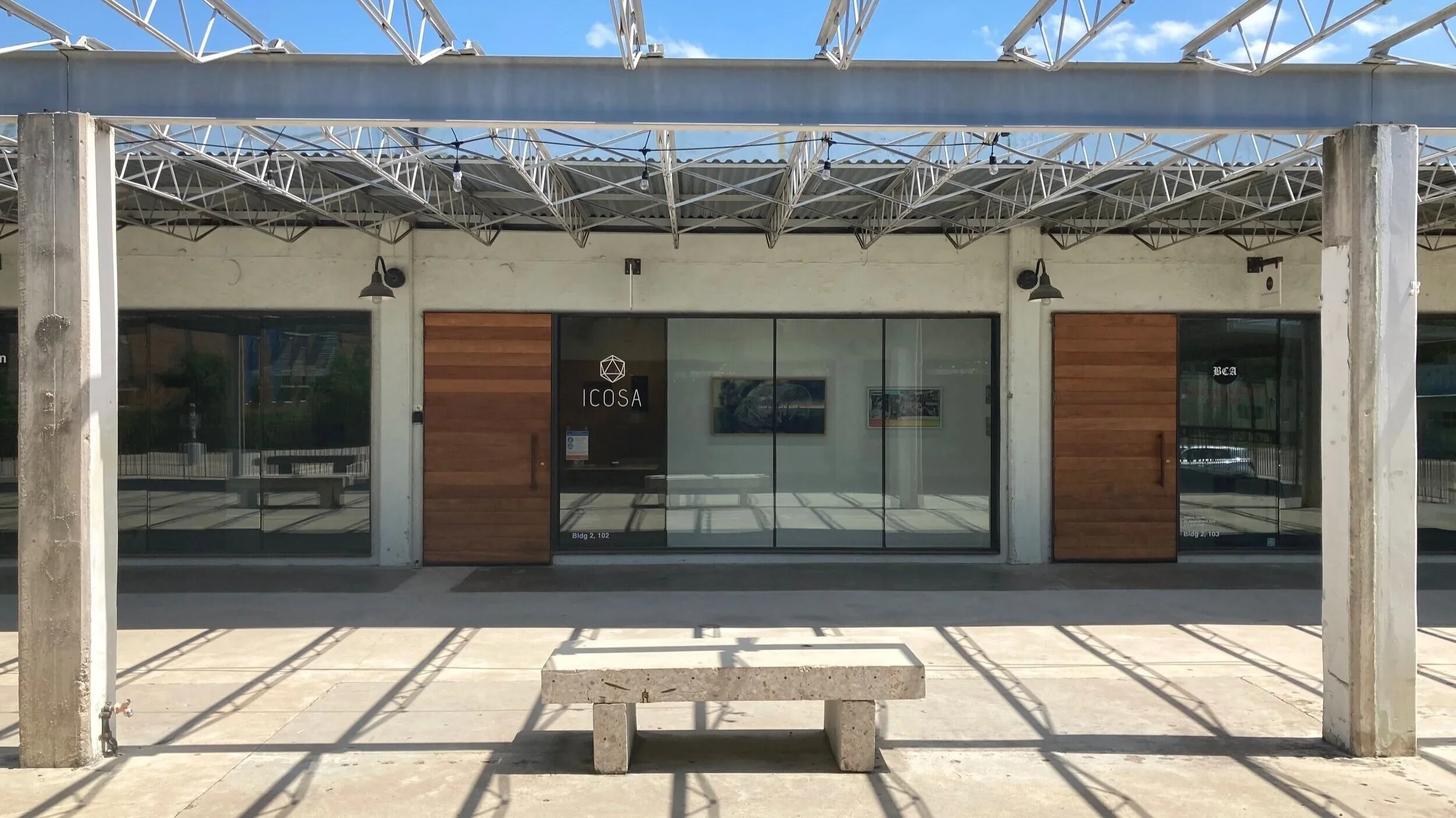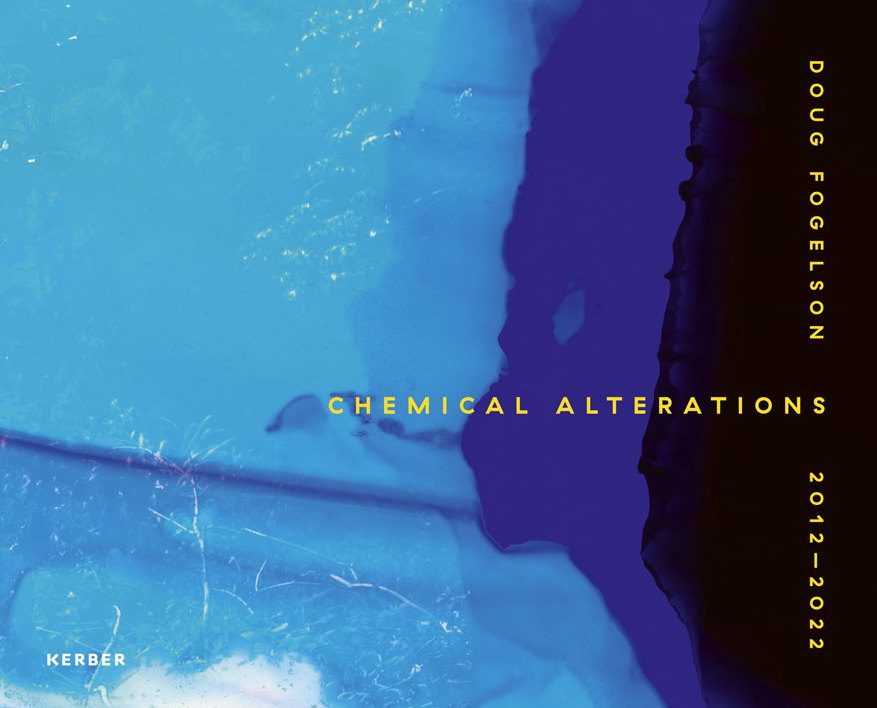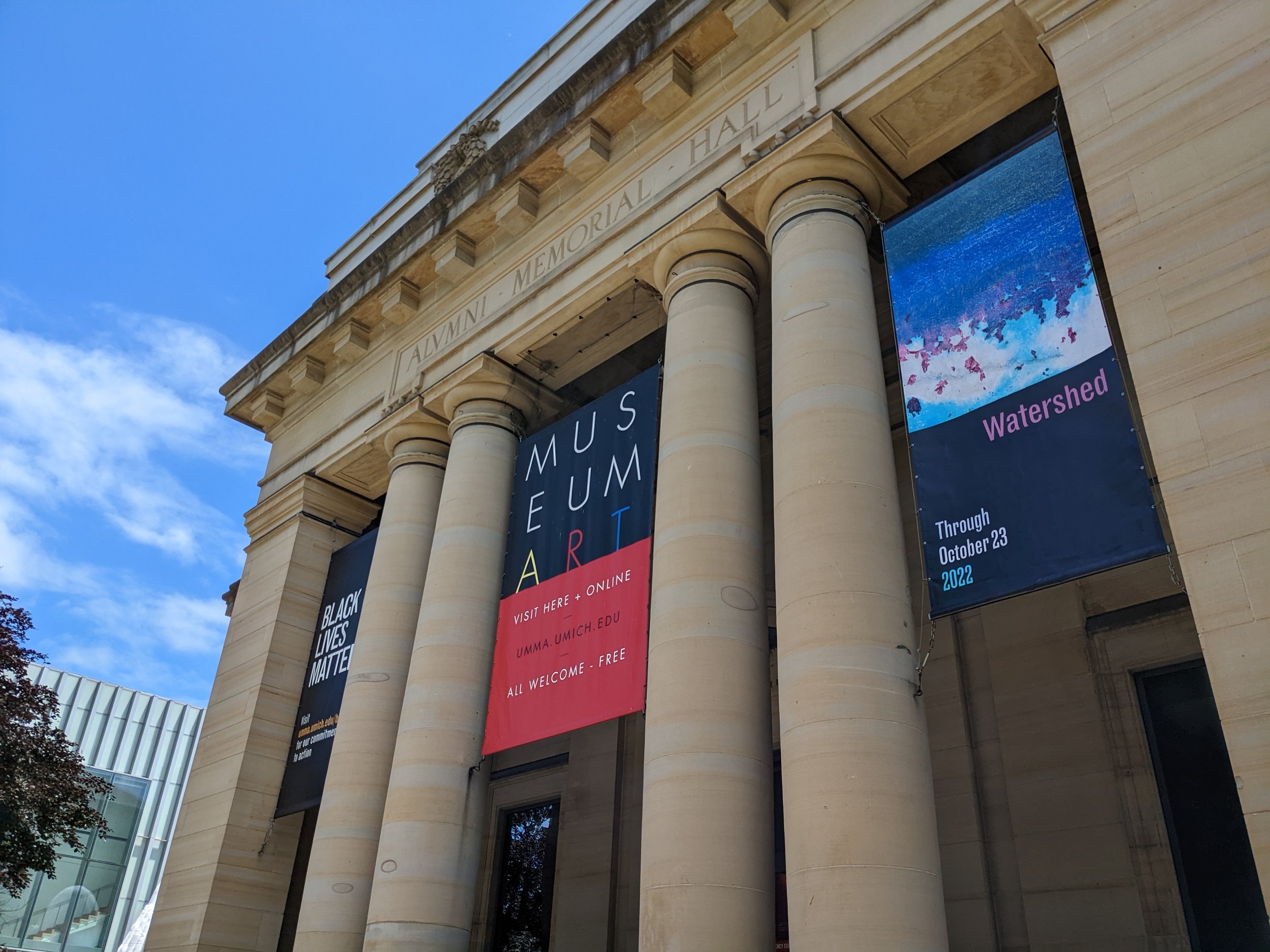Doug Fogelson, "Forms & Records No. 1A"
20 x 16 inches, 2024
4 Color Screenprint, 300 GSM Archival Paper.
Limited Edition of 30
This is the first in our new yearly series of limited editions made by Chicago artists. For this initial launch, artist Doug Fogelson made a print based on his Bauhaus inspired photograms.
“Forms & Records”, harkens back to the legacy of the original bauhaus via the New Bauhaus school in Chicago. Images from the original series were created in the very same darkroom used by teachers and students alike at the Institute of Design located in the basement of Mies van der Rohe’s Crown Hall. Source materials were vinyl 7” audio recordings from the 1950’s and 60’s and a set of translucent plastic geometric forms.
Signal Noise Preview
Introduced by Ayrika Hall, Curator
Signal Noise, a new series of photograms by Doug Fogelson, explores themes of chance, the interplay of light and time, and the material properties of photography against the concept of auditory signal-to-noise ratios. Within the realm of acoustics, a signal-to-noise ratio serves as a metric for delineating the balance between sought-after auditory signals and the intrusive, ancillary noise present in an audio recording. Similarly, Fogelson’s work encounters and embraces the components of chance and externality, elements inherent within the occasionally unpredictable realm of analog photography. Through the dual presence of control and lack of, his work parallels the auditory phenomenon, and central to the concept of signal-noise-ratios Fogelson’s work is emblematic of the symbioses of the intentional and the incidental.
Doug Fogelson, "Signal/Noise No. 2"
Archival inkjet.
60 x 42 inches, 2024
The production of photograms inherently engages with the incidental due to the procedural dynamics and the material specificity of the medium. In the creation of photograms, objects are strategically positioned upon photosensitive paper, which subsequently undergoes exposure to light. The incidental elements inherent in this process—ranging the opacity and spatial arrangement of the objects, fluctuations in light exposure, or alterations pertaining to chemical properties of the photosensitive medium at times risk introducing additional layers of variability. Consequently, the photogram emerges as a unique artifact of both deliberate intention and natural occurrence, encapsulating the interplay between controlled methodological inputs and the inherent unpredictability of the analog photographic process. This dialectic between the calculable and the contingent situates the photogram within a discourse akin to signal-noise-ratios, emphasizing the role of chance as a generative force within the medium’s aesthetic and conceptual exploration.
Described as an “homage to reverberation” Fogelson’s series establishes a dialogue between visual and auditory realms, emphasizing the material characteristics of mediums and their thematic reverberations. Fogelson’s technique for creating photograms involves physically manipulating grids and the application of various colors, creating a series of unique, and at times unintentional visual harmonics that imbue his photograms with an element of spontaneity representative of analog processes. Through his unique exploration of the medium, Fogelson’s work embodies an equilibrium between the aleatory and the deliberate, a defining characteristic throughout his oeuvre.
About the Artist
Doug Fogelson studied at The School of the Art Institute and Columbia College both in Chicago. Since then, his works have been exhibited globally with galleries and museums and are included in esteemed private and public collections such as The J. Paul Getty Center, Los Angeles; The Museum of Contemporary Photography, Chicago; Center for Creative Photography, Tucson, and the Staatliche Museum für Fotografie, Berlin. Fogelson’s artistic endeavors have been covered by The Brooklyn Rail, NewCity, Photo District News, and Hi-Fructose among others.
About the Curator
Ayrika Hall is an art historian and Doctoral candidate at the University of Illinois, Chicago, specializing in contemporary Black art. Hall’s research explores Black art’s historiography and its interaction with modern realities, questioning established methods to spotlight its multifaceted connections to society and politics. She has held curatorial, research, and programming roles at the Smart Museum of Art, Anthony Gallery, The Floating Museum, and the Chicago Architecture Biennial. Hall received her Master’s degree in Art History with a curatorial distinction from the University of Chicago in 2021, and her BA in History of Art and Architecture, Studio Art, and Museum Studies from DePaul University in 2020.
About blackpuffin Limited Editions
The curated limited editions offer a unique opportunity to collect affordable work from well-established artists. By collaborating directly with the artists we produce items and editioned artworks to further our mission of bringing art to a wider public. Each object is processed individually by hand to ensure the highest quality delivery. Signal Noise is the first of three upcoming collaborations between local Chicago artists who are paired with a curator from the African Diaspora.
About the Printer
Matthew Letzelter is an artist, professor, and professional printer. His work is defined by decades of exploring printmaking and publishing with multiple professional studios and programs in North America. He received his MFA in 2003 from Pratt Institute, Brooklyn, New York, and his BFA in 1998 from University of Florida. Letzelter was the Master Printer at Stinger Editions and Visiting Professor at Concordia University in Montreal, and Petersburg Press in New York City. He is currently Chair of the MFA in Print Media Program and Director of Watershed - Center for Print Research at Willamette university, Portland OR. The Watershed Center for Print Publishing and Research is the research and education extension of the printmaking lab at Pacific Northwest College of Art. Watershed welcomes visiting artists, researchers, and professional printers as well as the community to collaborate on editions and projects.
Interview
Curator Ayrika Hall in conversation with artist Doug Fogelson.
Doug Fogelson: Perhaps it’s best to share a little history about where this beautiful new Blackpuffin limited-edition screen print comes from…it’s kind of a fun story.
I was curious about the original darkroom that both students and teachers at the Institute of Design (the New Bauhaus in Chicago) had used, and heard it still existed in the basement of Mies van der Rohe’s Modernist masterwork structure called Crown Hall at IIT, however, the school said the darkroom itself was about to be remodeled and would be taken away soon. I confirmed that this was indeed the same space and equipment used by artists such as Barbara Crane, Ray Metzker, and many of the lauded artists that came through over the years. So, I asked, “can I go in and make something in there? Can I check it out?” and was kindly allowed access.
I gathered some material items to bring along: a small stack of vintage 45’s (7-inch vinyl records) and a set of translucent plastic shapes in different colors that reminded me of the original Bauhaus logos and color/shape assignments. But then–in a fortunate chance occurrence, architecture students working on the main floor of Crown Hall were at the end of their semester and they had super cool scale models of buildings that they had designed, with lovely details made by CNC routers and laser cutters in a variety of different materials, and they just threw them away into a big dumpster! I went outside, and discovered this dumpster and it was like a treasure chest. I literally jumped in and picked up bits and pieces from many broken, deconstructed models and brought those along into the old darkroom as well.
Together with these items, I had some color gels, a flashlight, etc. and started making photograms. In doing so I was also listening to the building itself, with its pipes and various sounds within, and I was kind of “listening” for more than that in a weird way, trying to hear or feel something that might connect me to the spirit of the place. Such was all in the mix, you know, at that time of creating the Forms & Records series.
Ayrika Hall: In your statement you engage with Wasilly Kandinsky's theories, which articulate a specific relationship between colors and shapes, wherein certain shapes are thought to correspond with certain colors based on their emotional resonance. I found a quote from Kandinsky wherein he notes “A dull shape like a circle deserves a dull color like blue. A shape with intermediate interest like a square deserves an intermediate color like red. A dynamic interesting shape like a triangle deserves an and energetic luminous psychotic color like yellow.” He implies a predefined harmony between form and color that's grounded in emotional and psychological impact. But, in in your series “Forms & Records” it seems like you were going against Kandinsky's, prescribed pairings of color and shape. For instance, in Forms and Records number 13, you create circular shapes with vibrant yellows, oranges, pinks, and greens. Yet, conversely in Forms & Records, black and white number 8, you altogether abstain from using color, focusing purely on the form itself. So, I wanted to ask if you could discuss the rationale between your approach to color and form, particularly how you decide to align with or diverge from traditional color form relationships as posited by Kandinsky--what drives your decision to either engage or negate color in your work?
Doug Fogelson: Nice question. I disagree with Kandinsky here. I don't think it's correct to assign color in such specific ways. I believe it's very subjective, so saying you know, red is always ‘passion’ and blue is always ‘peaceful’ or ‘contemplative’ feels a bit out of date now. Kandinsky's experiments and lessons to the students of the original Bauhaus were inspiring to me as a student, as were many of the people working in the New Bauhaus/Institute of Design. Some of these were direct mentors and teachers of mine here coming up in the Chicago scene.
My process involves a lot of chance. Colors used over multiple exposures are additive. For instance, one exposure may be yellow light, then the next blue light, anything that's not covered up by the “subject/object” then blends and becomes green. Subsequently stacked up exposures have a secondary, and tertiary, or greater combinations over the layers, it becomes quite hard to control or pre-visualize. Making the black and white photograms I was able to see the “subject/objects” under the red safelight, and therefore had more control at least over composition. Black and white is the OG of photography and the primary use of the darkroom there, so that was a must-do in the space, while using the color was a bit more experimental due to the total darkness it needs to be made.
Ayrika Hall: I enjoy your blend of chance and intentionality. And within your works. I'm thinking about a dark room--the physical sensation of being in a bathroom sized dark room within a cold basement, yet producing pieces that are very warm, very pink, red, and orange. It’s interesting that you create a piece that is both controlled by its environment but also resists the feeling of its environment. I find that very interesting.
Doug Fogelson: It's cool to muse about that relationship between intention and authorship, together with the process and a medium’s materiality. The screen print too is a whole other process as well, quite different than light-based, or photo materials –and yet related, stacking in visible layers that can be shuffled. So, depending on the medium you kind of bump up against limits or even push against certain limitations and change the typical outcome.
I always feel like a collaborator with chance and actively seek out ways to do so. Using color photogram becomes a dance between intention and chance, especially with the multiple exposures creating overlapping forms. Sometimes those forms describe more about the object-as-subject, its inherent qualities revealed formally, other times perhaps it can shift to an altogether different reading, though that is also quite subjective…
Ayrika Hall: Absolutely. Very cool. I also wanted to ask you a bit about the use of 45s In your Forms and Records series, you mentioned that you work with 7 inch vinyl’s--does the source materials content—i.e. lyrical content of the song, the contexts surrounding of the musician, etc. add layers to the works you're making-- or is your concern more so about the physical form of the record itself? In other words, does the content of the object you’re utilizing imbue your work with certain intentionality through your choice of materials? I am thinking a lot about how artists work within an archive--how artists address concepts such as, let's say, in nostalgia through reactivating archival material. Part of the reason I'm interested in this is because my primary art historical research interest is in black figurative painting. So, I often see how some of these artists work with sort of “broad archive”—an impersonal archive to reactivate, reclaim or reimagine histories. Many artists treat an archive as a medium in itself, similar to how a painter would use paint or a photographer would use a camera, the archive is the medium. So, I was curious. Where do you feel your work Falls in relation to the intentions of reactivating an archive?
Also, I was very drawn to how you noted that you were trying to embrace some of the creative spirit of the new Bauhaus “seeking a kinship with the ghosts of the past.” So similar to how working in that space suggests a closeness or access to some of these latent energies, do you feel similarly about the properties, or latent energies of a vinyl in terms of its content.
Doug Fogelson: Oh yeah, 100%, 150%.
I spend most of my days working in the studio listening to older music. I've been living in an archive–a shared archive consisting of a few people's collections, including my own. Luckily, I’ve been in a round robin over the years with some DJ friends who are deep crate diggers. This means I don't know a ton of contemporary music, but do listen to things that are around… So, the symbol of the 7” record is both a circle (that fit the size of my paper and film) but it was also the new technology in the timeframe around the Institute of Design and onward from the mid 1950’s. Of course, even now there's been resurgence for vinyl, but back then it was a new thing, you know, followed by cassettes and so on, CDs, and so it was a marker in time that felt appropriate. Records (and analog photo materials) are symbolic artifacts with built in nostalgia that also last in a way that's rather different to how we have all our stuff on hard drives or cloud computing today.
The visual result of these works does seem to display a bit of a “synesthesia” where the forms become slightly prismatic and reference lyrical sound. I tend to work with natural materials because I'm exploring ideas about a sort of ephemerality, cycles of time, or referencing changes through antiquated objects that were technological in nature, and now an archive of sorts. All the physical items I use to make photograms have their own backstories, where or how I found them, they share a lot of commonalities too as things that are usually readily available and not particularly precious.
I continue to find value in exploring photography, music, film, etc. for both the “storage” and/or “stoppage” of time aspects and more importantly from the feelings that come about from viewing or replaying what has been recorded.





















